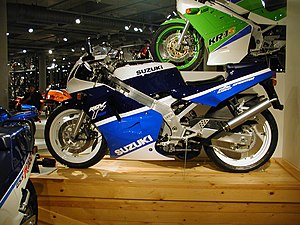This article possibly contains original research. (May 2009) |
 | |
| Manufacturer | Suzuki |
|---|---|
| Production | 1988–1998 |
| Predecessor | Suzuki RG250 Gamma |
| Class | Sport bike |
| Engine | 249 cc (15.2 cu in) two-stroke 90° V-Twin |
| Bore / stroke | 54 mm × 54.5 mm (2.13 in × 2.15 in) |
| Power | 62 hp (46 kW) (unrestricted)[1] |
| Transmission | Six-speed manual |
| Brakes | Drilled vented discs front and rear |
| Wheelbase | 54.3 in (1,380 mm) |
| Weight | 305 lb (138 kg) (dry) 345 lb (156 kg) (wet) |
| Related | Aprilia RS250 as it shares the same engine |
The Suzuki RGV250 was a Suzuki high performance sport bike which had a great number of its features and design cues based on Grand Prix technologies and ideas. It is a race-replica based on Suzuki's 250 cc (15 cu in) GP bikes from 1987 to 1998, the RGV V-2 racer. This motorcycle replaced the RG250 Gamma, which employed an alloy frame with a two-stroke parallel twin engine. The bike produced over 60 bhp in a narrow power band between 8,000 and 11,000 rpm. The dry weight ranged between 128 kg (282 lb) (1989) to 140 kg (309 lb) (later models) dry weight.[citation needed]
The top speed of a standard RGV250 is around 130 mph (209 km/h). It has a 0-60 mph (97 km/h) time of around 3.7 seconds.[citation needed]
This motorcycle's engine performance is not very inspiring at engine speeds under 7,000 rpm, due to the two-stroke engine power delivery of a relatively narrow power band. However, once the engine is revved over 8,000 rpm, the power delivery characteristics effectively doubles, as is expected of a two-stroke racing motorcycle.
Due to its light weight, engine characteristics and cornering capabilities, it is particularly suited to the track, compared to other motorcycles of similar engine capacity.
- ^ Ienatsch, Nick (January 8, 2018). "The Once-Banned 250cc Two-Stroke Sportbike Enters A New Haven Of Legend—Old Enough To Be Legal". Cycle World. Retrieved January 12, 2018.